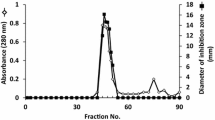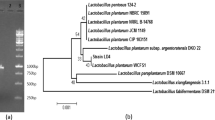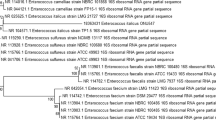Abstract
In the present research, the strain SLYY-3 was isolated from sediments of Jiaozhou Bay, Qingdao, China. The strain SLYY-3, which produced a bacteriocin-like substance (BLS), was characterized to be a strain of Bacillus subtillis by biochemical profiling and 16S rDNA sequence analysis. It is the first time to report that Bacillus subtilis from Jiaozhou Bay sediments could produce a BLS. The BLS of B. subtillis SLYY-3 exhibited strong inhibitory activity against gram-positive bacteria (including Staphylococcus aureus and B. subtillis) and some fungi (including Penicillium glaucum, Aspergillus niger and Aspergillus flavus). The antimicrobial activity was detected from culture in the exponential growth phase and reached its maximum when culture entered into stationary growth phase. It was thermo-tolerant even when being kept at 100°C for 60 min without losing any activity and stable over a wide pH range from 1.0 to 12.0 while being inactivated by proteolytic enzyme and trypsin, indicating the proteinaceous nature of the BLS. The BLS was purified by precipitation with hydrochloric acid (HCl) and gel filteration (Sephadex G-100). SDS-PAGE analysis of the extracellular peptides of SLYY-3 revealed a bacteriocin-like protein with a molecular mass of 66 kDa. Altogether, these characteristics indicate the potential of the BLS for food industry as a protection against pathogenic and spoilage microorganisms.
Similar content being viewed by others
References
Anacarso, I., Messi, P., Condò, C., Iseppi, R., Bondi, M., Sabia, C., and de Niederhäusern, S., 2014. A bacteriocin-like substance produced from Lactobacillus pentosus 39 is a natural antagonist for the control of Aeromonas hydrophila and Listeria monocytogenes in fresh salmon fillets. Food Science and Technology, 55: 604–611.
Balciunas E. M., Martinez, F. A. C., Todorov, S. D., de Melo Franco, B. D. G., Converti, A., and de Souza Oliveira, R. P., 2013. Novel biotechnological applications of bacteriocins: A review. Food Control, 32: 134–142.
Baugher, J. L., and Klaenhammer, T. R., 2011. Application of omics tools to understanding probiotic functionality. Journal of Dairy Science, 94: 4753–4765.
Bizani, D., and Brandelli, A., 2002. Characterization of a bacteriocin produced by a newly isolated Bacillus sp. strain 8A. Journal of Applied Microbiology, 93: 512–519.
Cherif, A., Ouzari, H., Daffonchio, D., Cherif, H., Ben Slama, K., Hassen, A., Jaoua, S., and Boudabous, A., 2001. Thuricin 7: A novel bacteriocin produced by Bacillus thuringiensis BMG17, a new strain isolated from soil. Letters in Applied Microbiology, 32: 243–247.
Cherif, A., Chehimi, S., Limen, F., Hansen, B. M., Hendriksen, N. B., Daffonchio, D., and Boudabous, A., 2003. Detection and characterization of the novel bacteriocin entomocin 9, and safety evaluation of its producer, Bacillus thuringiensis ssp. entomocidus HD9. Journal of Applied Microbiology, 95: 990–1000.
Cladera-Olivera, F., Caron, G. R., and Brandelli, A., 2004. Bacteriocin-like peptide production by Bacillus licheniformis strain P40. Letters in Applied Microbiology, 38: 251–256.
Edwards, U., Rogall, T., Bocker, H., Emde, M., and Bottger, E., 1989. Isolation and direct complete nucleotide determination of entire genes. Characterization of a gene coding for 16S ribosomal DNA. Nucleic Acids Research, 17: 7843–7853.
Gray, E. J., Lee, K. D., Souleimanov, A. M., Di Falco, M. R., Zhou, X., Ly, A., Charles, T. C., Driscoll, B. T., and Smith, D. L., 2006. A novel bacteriocin, thuricin 17, produced by plant growth promoting rhizobacteria strain Bacillus thuringiensis NEB17: Isolation and classification. Journal of Applied Microbiology, 100: 545–554.
He, L. L., Chen, W. L., and Liu, L., 2006. Production and partial characterization of bacteriocin-like pepitdes by Bacillus licheniformis ZJU12. Microbiological Research, 161: 321–326.
Kayalvizhi, N., and Gunasekaran, P., 2008. Production and characterization of a low molecular weight bacteriocin from Bacillus licheniformis MKU3. Letters in Applied Microbiology, 47: 600–607.
Khochamit, N., Siripornadulsil, S., Sukon, P., and Siripor nadulsil, W., 2013. Characterization of bacteriocin-producing Bacillus subtilis KKU213 and its potential as a probiotic strain. Current Opinion in Biotechnology, 24: S36.
Laemmli, U. K., 1970. Cleavage of structural proteins during the assembly of the head of bacteriophage T4. Nature, 227: 680–685.
Lee, K. H., Jun, K. D., Kim, W. S., and Paik, H. D., 2001. Partial characterization of polyfermenticin SCD, a newly identified bacteriocin of Bacillus polyfermenticus. Letters in Applied Microbiology, 32: 146–151.
Li, J. F., Chi, Z. M., Li, H. F., and Wang, X. H., 2008. Characterization of a mutant of Alteromonas aurantia A18 and its application in mariculture. Journal of Ocean University of China, 7(1): 55–59.
Liu, Q. L., Gao, G., Xu, H. J., and Qiao, M. Q., 2012. Identification of the bacteriocin subtilosin A and loss of purL results in its high-level production in Bacillus amyloliquefaciens. Research in Microbiology, 163: 470–478.
McAulife, O., Ross, R. P., and Hill, C., 2001. Lantibiotics: Structure, biosynthesis and mode of action. FEMS Microbiology Reviews, 25: 285–308.
Riley, M. A., and Wertz, J. E., 2002. Bacteriocins: Evolution, ecology and application. Annual Review of Microbiology, 56: 117–137.
Saitou, N., and Nei, M., 1987. The neighbor-joining method: A new method for reconstructing phylogenetic trees. Molecular Biology and Evolution, 4: 406–425.
Samy, R. P., Gopalakrishnakone, P., Bow, H., Puspharaj, P. N., and Chow, V. T. K., 2010. Identification and characterization of a phospholipase A2 from the venom of the Saw-scaled viper: Novel bactericidal and membrane damaging activities. Biochimie, 92: 1854–1866.
Senbagam, D., Gurusamy, R., and Senthilkumar, B., 2013. Physical chemical and biological characterization of a new bacteriocin produced by Bacillus cereus NS02. Asian Pacific Journal of Tropical Medicine, 12: 934–941
Tamura, K., Dudley, J., Nei, M., and Kumar, S., 2007. MEGA4: Molecular Evolutionary Genetics Analysis (MEGA) Software Version 4.0. Molecular Biology and Evolution, 24: 1596–1599.
Thompson, J. D., Higgins, D. G., and Gibson, T. J., 1994. CLUSTAL W: Improving the sensitivity of progressive multiple sequence alignment through sequence weighting, position-specific gap penalties and weight matrix choice. Nucleic Acids Research, 22: 4673–4680.
Turgis, M., Vu, K. D., Dupont, C., and Lacroix, M., 2012. Combined antimicrobial effect of essential oils and bacteriocins against foodborne pathogens and food spoilage bacteria. Food Research International, 48: 696–702.
von Döhren, H., 1995. Peptides. In: Genetics and Biochemistry of Antibiotic Production. Vining, L. C., and Stuttard, C., eds., Studtard, Boston, 129–171.
Author information
Authors and Affiliations
Corresponding author
Rights and permissions
About this article
Cite this article
Li, J., Li, H., Zhang, Y. et al. Characterization of a bacteriocin-like substance produced from a novel isolated strain of Bacillus subtilis SLYY-3. J. Ocean Univ. China 13, 995–999 (2014). https://doi.org/10.1007/s11802-014-2547-z
Received:
Revised:
Accepted:
Published:
Issue Date:
DOI: https://doi.org/10.1007/s11802-014-2547-z




